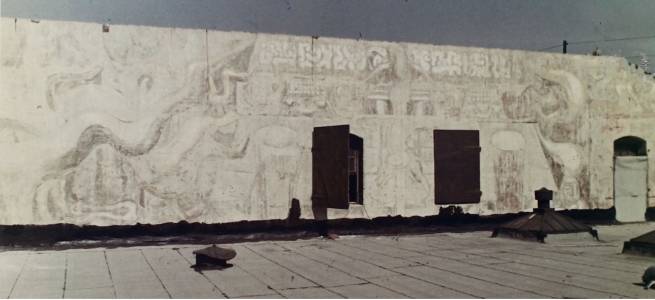dieser beitrag wurde verfasst in: englisch (eng/en)
künstler (in grau: assistent/in): David Siqueiros, Maria Andrade, Luis Arenal Bastar, Jacob Assanger, Peter Ballbusch, Victor Hugo Basinet, Roberto Berdecio, Wiard Boppo Ihnen, Dean Cornwell, Stephen de Hospodar, Karoly Fulop, Dorothy Virginia Groton, Murray Hantman, Harold Hemenway Jones, Arthur Hinchman, James Hyde, Reuben Kadish, John Kehoe, Richard Franz Kollorsz, Martin Felix Obzina, Jean Osborne Abel , Sanford L. Pollock, Leandro Reveles, Tony Reveles, Frederick John Vrain Schwankowsky, Myer Shaffer, Jean Stewart, Ivan Stoppe, Jeannette Summers, Wolo von Trutzschler, John Weiskal
titel: Tropical America oppressed and destroyed by imperialism
jahr: 1932
adresse: Italian hall (Plaza Art Center), Olvera Street / North Main Street, Los Angeles, CA
+: Fresco on Portland cement, 3 x 9 m (19 ¾ x 98 ⅜ ft). Whitewashed in 1938, restored from 1988 on.
«In 1932 a mural was painted on Olvera Street, the birthplace of Los Angeles, by the great maestro David Alfaro Siqueiros, the Mexican muralist/painter. Siqueiros was the last of Los Tres Grandes (The Three Great Muralists), who after the 1910 revolution in Mexico began a cultural revolution that taught the precepts of the revolution and the history of Mexico through murals. Siqueiros, the most revolutionary of the three in materials usage, social intent and content, worked for a period of time in Los Angeles. His 80-foot-long mural America Tropical spoke to the exploitation of the Mexican worker. Commissioned by the city fathers for a Bavarian beer garden (owned by a Nazi), the mural was intended to depict a kitschy Mexican village scene for the benefit of tourists. Instead, Siqueiros made the central image of the mural a crucified figure.
With increasing demand for low-wage immigrant labor and massive migrations of Mexican and Central American workers to Los Angeles over the last 10 or 15 years, this image is even more relevant today than in the ’30s. The mural was partially whitewashed shortly after its completion and then fully painted over within its first year on public view beginning a legacy of censorship that still haunts Los Angeles. In the 1970′s, forty years after it was painted over, the image began to reemerge from the whitewash. We saw this as a symbol, an aparicion (religious apparition), coinciding with the growth of Los Angeles’s Mexican population and strength of the Chicano movement.» (Judy Baca, SPARC, 2001)
«Shortly after the unveiling of Street Meeting Siqueiros received a new proposition from the Plaza Art Center’s Director and C[alifornia]A[rt]C[lub] member Ferenz to paint another mural at Olvera Street. This project called for a much larger team of assistants under Siqueiros’ instruction, as the new project would tackle a wall measuring 82 by 18 feet on the second story of an old Italian Hall.
[…] Twenty-nine artists (including four women) assisted Siqueiros on América Tropical […]
[…] at the October 9th unveiling at which Cornwell gave an address, it was reported that the crowd “gasped” when the scaffolding was finally removed. For a second time, opinions of the mural were sharply divided. Great admiration came from the artists, like CAC member Lorser Feitelson (1898–1978) who recalled “…it had guts in it! It made everything else of the time look like candybox illustrations. Many of the artists said, ‘My God! This is wonderful vocabulary!’”
But there was a muted seething from city officials, and southern California’s sunny skies wouldn’t gaze down on the mural for very long. At some point between Siqueiros’ looming departure and April 1934, Ferenz was obliged to paint over part of the mural, notably the right-hand section which could be seen from the street, though he made sure “a harmless covering” was employed. […]
There has also been a push to rediscover and preserve América Tropical on Olvera Street, on-going since the early 1970s but only now gaining steam. Los Angeles and its Mayor Antonio Villaraigosa have partnered with the Getty Institute and its Director Tim Whalen to preserve the landmark; though instead of restoring or repainting the faded mural, the Getty has painstakingly worked to preserve what is left. Although far from a done deal, the current plan to have the site restored for public viewing seems on track and is set to be finished by September 2010, the centennial of the Mexican Revolution with which Siqueiros identified so strongly. The historic Sepulveda House on Olvera Street will house an interpretive center for exhibitions, as well as contain a color replica of what the mural might have looked like. » (Merrell, 2010)
